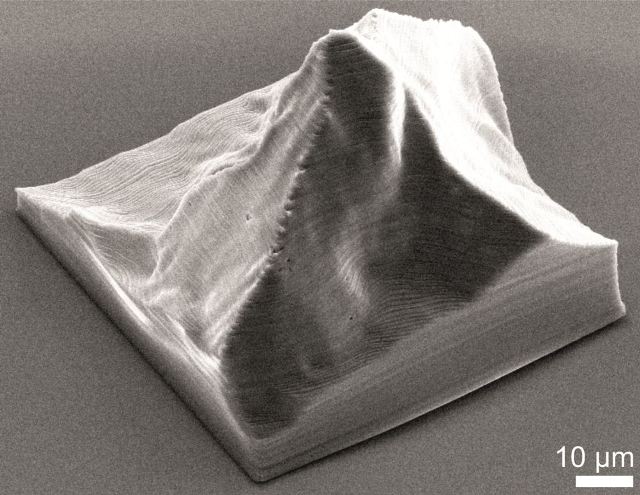Feb 12 2016
Researchers at the Paul Scherrer Institute have produced large numbers of detailed models of the Matterhorn, each one less than a tenth of a millimetre in size. With this, they demonstrated how 3-D objects so delicate could be mass-produced. Materials whose surface is covered with a pattern of such tiny 3-D structures often have special properties. What nature has exploited for so long could be instructive for a number of industrial applications. Many snakes glide over sand aided by 3-D structures on their skin that significantly reduce friction. Along the same lines, machine parts could be furnished with a comparable structure, thereby minimizing wear and tear.
 Electron micrograph of a 3-D model of the Matterhorn. The bar indicates a length of 10 micrometres, that is, one hundredth of a millimetre. (Figure: Paul Scherrer Institute)
Electron micrograph of a 3-D model of the Matterhorn. The bar indicates a length of 10 micrometres, that is, one hundredth of a millimetre. (Figure: Paul Scherrer Institute)
Researchers of the Paul Scherrer Institute (PSI) have produced tiny and highly detailed models of the Matterhorn. Each model is only around seven hundredths of a millimetre, making its height less than the thickness of a sheet of paper. In addition, the models are so detailed that individual structural features of the Matterhorn are clearly represented: like its summit, for example, which in the model has a diameter of 100 nanometres, barely as big as a virus.
Manufacturing these models is not just a gimmick: Surfaces that are covered with such tiny 3-D objects often have special properties that make them useful and versatile. "You can observe these kinds of properties in nature," explains Helmut Schift, leader of the research project at the PSI. "For example, many species of snakes are able to glide over sand without significantly wearing down their skin." The skin of these snakes has scales and ridges just a few thousandths of a millimetre high. This strongly reduces friction in one direction. "One could imagine," Schift continues, "furnishing machine parts that are exposed to powerful stresses through friction with a similarly structured surface. That would sharply reduce the component’s wear and tear." The Matterhorns were fabricated to prove the feasibility of precisely manufacturing such small structures deliberately and reproducibly.
3-D printing on the nanoscale
In order to fabricate the Matterhorn models, the researchers used a particularly detailed type of 3-D printing known as 3-D photolithography. (Experts refer to it as two-photon lithography.) "We make the structures out of a light-sensitive material," explains Robert Kirchner, a scientist at the PSI. "In places where the illumination is especially intense, the initially fluid material becomes hard, and the remaining material can be washed away. To expose the material, we use a special laser whose beam is only intense enough to alter the material at the focal point of a lens. We move this focal point through the material. Thus we can determine, for every individual nanometre-sized point, whether the material will wash away in the end or stay put. In this way we can fabricate almost arbitrarily complex objects with nanoscale details."
This serial laser procedure is in fact quite laborious; however, it only needs to be carried out once. To fabricate copies of an individual 3-D structure — such as the Matterhorn, for example — a mould is made with the help of this original. With that, in turn, the structures can be cast in great numbers and thus replicated in mass production.
Text: Paul Scherrer Institut/Paul Piwnicki